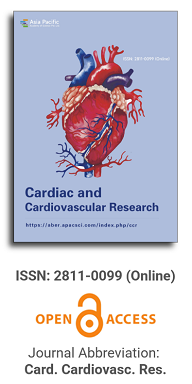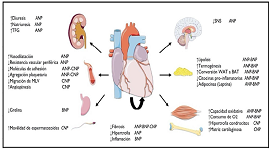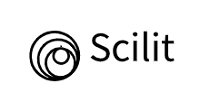
Asia Pacific Academy of Science Pte. Ltd. (APACSCI) specializes in international journal publishing. APACSCI adopts the open access publishing model and provides an important communication bridge for academic groups whose interest fields include engineering, technology, medicine, computer, mathematics, agriculture and forestry, and environment.

Bubbles help in troubles: Contrast-enhanced ultrasound (CEUS) as a predictor of recurrence for TIA/stroke in low-grade internal carotid artery stenosis
Vol 6, Issue 1, 2025
Download PDF
Abstract
Introduction: Contrast-enhanced ultrasound (CEUS) allows the visualization of atherosclerotic plaque neovessels, which are the hallmark of carotid plaque instability. Aim: The purpose of our prospective study was to check the correlation between carotid CEUS analysis and the recurrence of TIA/stroke in patients with a previous recent TIA/stroke and neurological impairment congruent with vascular stenosis. Materials and methods: From November 2021 to May 2023, 62 consecutive patients (mean age 73.8 ± 12.2, 51 female) with a TIA/stroke in the previous 30 days underwent carotid ultrasound and carotid CEUS in an outpatient setting after 10 days from the acute event. The inclusion criteria were one atherosclerotic plaque inside the internal carotid artery, congruent with symptoms, which was causing a stenosis of less than 50% (low-grade stenosis). The carotid plaque neovascularization scoring method was score 0: no visible microbubbles within the plaque (A); score 1: minimal microbubbles confined to periadventitial (B); and score 2: microbubbles present throughout the plaque core (C). During the 6-month, 12-month, and 18-month follow-ups, we checked TIA/stroke recurrences. A multivariable logistic regression analysis was performed. P < 0.05 was considered significant. Results: In our series, 22% of patients have a CEUS score of 0, 35% have a CEUS score of 1, and 43% have a CEUS score of 2. At six-month follow-up, we found 21% TIA/stroke recurrences in CEUS score 2, despite the ongoing best medical therapy as per guidelines. At 12-month follow-up, we did not find any recurrence of cerebrovascular events. In Cox regression analysis, CEUS-detected neovascularization was independently associated with TIA/stroke recurrence (hazard ratio, 5.37; 95% confidence interval, 1.36–2.31). Conclusions: Plaque neovascularization, detected by CEUS, is an independent predictor of TIA/stroke recurrence at six-month follow-up in patients with carotid atherosclerosis despite low-grade stenosis. This diagnostic method can guide the best surgical vs. medical choice in the treatment of low-grade carotid stenosis, which is determined by soft atherosclerotic plaque.
Keywords
References
1. Song P, Fang Z, Wang H, et al. Global and regional prevalence, burden, and risk factors for carotid atherosclerosis: a systematic review, meta-analysis, and modelling study. Lancet Glob Health. 2020; 8(5): e721-e729.
2. Nezu T, Hosomi N, Aoki S, et al. Carotid Intima-Media Thickness for Atherosclerosis. Journal of Atherosclerosis and Thrombosis. 2016; 23(1): 18-31. doi: 10.5551/jat.31989
3. Liu YT, Zhang ZMY, Li ML, et al. Association of carotid artery geometries with middle cerebral artery atherosclerosis. Atherosclerosis. 2022; 352: 27-34. doi: 10.1016/j.atherosclerosis.2022.05.016
4. Naylor AR, Ricco JB, de Borst GJ, et al. Editor’s Choice – Management of Atherosclerotic Carotid and Vertebral Artery Disease: 2017 Clinical Practice Guidelines of the European Society for Vascular Surgery (ESVS). European Journal of Vascular and Endovascular Surgery. 2018; 55(1): 3-81. doi: 10.1016/j.ejvs.2017.06.021
5. Zeebregts CJ, Paraskevas KI. The New 2023 European Society for Vascular Surgery (ESVS) Carotid Guidelines – The European Perspective. European Journal of Vascular and Endovascular Surgery. 2023; 65(1): 3-4. doi: 10.1016/j.ejvs.2022.04.033
6. Bonati LH, Kakkos S, Berkefeld J, et al. European Stroke Organisation guideline on endarterectomy and stenting for carotid artery stenosis. European Stroke Journal. 2021; 6(2): I-XLVII. doi: 10.1177/23969873211012121
7. Brinjikji W, Huston J, Rabinstein AA, et al. Contemporary carotid imaging: from degree of stenosis to plaque vulnerability. Journal of Neurosurgery. 2016; 124(1): 27-42. doi: 10.3171/2015.1.jns142452
8. Li Z, Xu X, Ren L, et al. Prospective Study About the Relationship Between CEUS of Carotid Intraplaque Neovascularization and Ischemic Stroke in TIA Patients. Frontiers in Pharmacology. 2019; 10. doi: 10.3389/fphar.2019.00672
9. Lioznovs A, Radzina M, Saule L, et al. What Is the Added Value of Carotid CEUS in the Characterization of Atherosclerotic Plaque? Medicina. 2024; 60(3): 375. doi: 10.3390/medicina60030375
10. Feinstein SB. Contrast Ultrasound Imaging of the Carotid Artery Vasa Vasorum and Atherosclerotic Plaque Neovascularization. Journal of the American College of Cardiology. 2006; 48(2): 236-243. doi: 10.1016/j.jacc.2006.02.068
11. Schinkel AFL, Bosch JG, Staub D, et al. Contrast-Enhanced Ultrasound to Assess Carotid Intraplaque Neovascularization. Ultrasound in Medicine & Biology. 2020; 46(3): 466-478. doi: 10.1016/j.ultrasmedbio.2019.10.020
12. Dong S, Hou J, Zhang C, et al. Diagnostic Performance of Atherosclerotic Carotid Plaque Neovascularization with Contrast-Enhanced Ultrasound: A Meta-Analysis. Computational and Mathematical Methods in Medicine. 2022; 2022: 1-8. doi: 10.1155/2022/7531624
13. Zhu C, Li Z, Ju Y, et al. Detection of Carotid Webs by CT Angiography, High‐Resolution MRI, and Ultrasound. Journal of Neuroimaging. 2020; 31(1): 71-75. doi: 10.1111/jon.12784
14. Camps‐Renom P, Prats‐Sánchez L, Casoni F, et al. Plaque neovascularization detected with contrast‐enhanced ultrasound predicts ischaemic stroke recurrence in patients with carotid atherosclerosis. European Journal of Neurology. 2020; 27(5): 809-816. doi: 10.1111/ene.14157
15. Mantella LE, Colledanchise KN, Hétu MF, et al. Carotid intraplaque neovascularization predicts coronary artery disease and cardiovascular events. European Heart Journal - Cardiovascular Imaging. 2019; 20(11): 1239-1247. doi: 10.1093/ehjci/jez070
16. Coli S, Magnoni M, Sangiorgi G, et al. Contrast-Enhanced Ultrasound Imaging of Intraplaque Neovascularization in Carotid Arteries. Journal of the American College of Cardiology. 2008; 52(3): 223-230. doi: 10.1016/j.jacc.2008.02.082
17. Upadhyay A, Dalvi SV. Microbubble Formulations: Synthesis, Stability, Modeling and Biomedical Applications. Ultrasound in Medicine & Biology. 2019; 45(2): 301-343. doi: 10.1016/j.ultrasmedbio.2018.09.022
18. Zlitni A, Gambhir SS. Molecular imaging agents for ultrasound. Current Opinion in Chemical Biology. 2018; 45: 113-120. doi: 10.1016/j.cbpa.2018.03.017
19. Evdokimenko AN, Gulevskaya TS, Druina LD, et al. Neovascularization of Carotid Atherosclerotic Plaque and Quantitative Methods of Its Dynamic Assessment in Vivo. Bulletin of Experimental Biology and Medicine. 2018; 165(4): 521-525. doi: 10.1007/s10517-018-4208-5
20. Ignatyev IM, Gafurov MR, Krivosheeva NV. Criteria for Carotid Atherosclerotic Plaque Instability. Annals of Vascular Surgery. 2021; 72: 340-349. doi: 10.1016/j.avsg.2020.08.145
21. Rotzinger DC, Qanadli SD, Fahrni G. Imaging the Vulnerable Carotid Plaque with CT: Caveats to Consider. Comment on Wang et al. Identification Markers of Carotid Vulnerable Plaques: An Update. Biomolecules 2022, 12, 1192. Biomolecules. 2023; 13(2): 397. doi: 10.3390/biom13020397
22. Huang R, Abdelmoneim SS, Ball CA, et al. Detection of Carotid Atherosclerotic Plaque Neovascularization Using Contrast Enhanced Ultrasound: A Systematic Review and Meta-Analysis of Diagnostic Accuracy Studies. Journal of the American Society of Echocardiography. 2016; 29(6): 491-502. doi: 10.1016/j.echo.2016.02.012
23. Li F, Gu SY, Zhang LN, et al. Carotid plaque score and ischemic stroke risk stratification through a combination of B-mode and contrast-enhanced ultrasound in patients with low and intermediate carotid stenosis. Frontiers in Cardiovascular Medicine. 2023; 10. doi: 10.3389/fcvm.2023.1209855
24. Rerkasem A, Orrapin S, Howard DP, et al. Carotid endarterectomy for symptomatic carotid stenosis. Cochrane Database of Systematic Reviews. 2020; 2020(9). doi: 10.1002/14651858.cd001081.pub4
25. Magnoni M, Ammirati E, Moroni F, et al. Impact of Cardiovascular Risk Factors and Pharmacologic Treatments on Carotid Intraplaque Neovascularization Detected by Contrast-Enhanced Ultrasound. Journal of the American Society of Echocardiography. 2019; 32(1): 113-120.e6. doi: 10.1016/j.echo.2018.09.001
26. Boswell-Patterson CA, Hétu MF, Kearney A, et al. Vascularized Carotid Atherosclerotic Plaque Models for the Validation of Novel Methods of Quantifying Intraplaque Neovascularization. Journal of the American Society of Echocardiography. 2021; 34(11): 1184-1194. doi: 10.1016/j.echo.2021.06.003
27. Lyu Q, Tian X, Ding Y, et al. Evaluation of Carotid Plaque Rupture and Neovascularization by Contrast-Enhanced Ultrasound Imaging: an Exploratory Study Based on Histopathology. Translational Stroke Research. 2020; 12(1): 49-56. doi: 10.1007/s12975-020-00825-w
28. Li Z, Wang Y, Wu X, et al. Studying the Factors of Human Carotid Atherosclerotic Plaque Rupture, by Calculating Stress/Strain in the Plaque, Based on CEUS Images: A Numerical Study. Frontiers in Neuroinformatics. 2020; 14. doi: 10.3389/fninf.2020.596340
29. Fresilli D, Di Leo N, Martinelli O, et al. 3D-Arterial analysis software and CEUS in the assessment of severity and vulnerability of carotid atherosclerotic plaque: a comparison with CTA and histopathology. La radiologia medica. 2022; 127(11): 1254-1269. doi: 10.1007/s11547-022-01551-z
30. Školoudík D, Kešnerová P, Vomáčka J, et al. Shear-Wave Elastography Enables Identification of Unstable Carotid Plaque. Ultrasound in Medicine & Biology. 2021; 47(7): 1704-1710. doi: 10.1016/j.ultrasmedbio.2021.03.026
31. Marlevi D, Maksuti E, Urban MW, et al. Plaque characterization using shear wave elastography—evaluation of differentiability and accuracy using a combined ex vivo and in vitro setup. Physics in Medicine & Biology. 2018; 63(23): 235008. doi: 10.1088/1361-6560/aaec2b
32. Marlevi D, Mulvagh SL, Huang R, et al. Combined spatiotemporal and frequency-dependent shear wave elastography enables detection of vulnerable carotid plaques as validated by MRI. Scientific Reports. 2020; 10(1). doi: 10.1038/s41598-019-57317-7
33. Torres G, Czernuszewicz TJ, Homeister JW, et al. Delineation of Human Carotid Plaque Features In Vivo by Exploiting Displacement Variance. IEEE Transactions on Ultrasonics, Ferroelectrics, and Frequency Control. 2019; 66(3): 481-492. doi: 10.1109/tuffc.2019.2898628
Supporting Agencies
Copyright (c) 2025 Author(s)
License URL: https://creativecommons.org/licenses/by/4.0/

This site is licensed under a Creative Commons Attribution 4.0 International License (CC BY 4.0).

Prof. Prakash Deedwania
University of California,
San Francisco, United States




